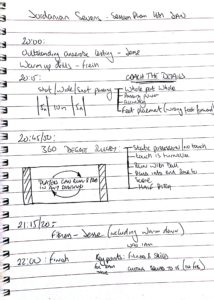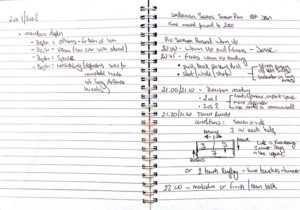At the time of writing, we’re midway through preparing for the Arab Nations Sevens Cup (ANSC). By we, I mean the Jordanian Rugby Sevens National team, who I’ve been coaching since last January. This is, in fact, my second tournament with the squad.
As you may have seen I’ve been posting some small clips on social media of the squad doing drills and small games from our training sessions (one of which is on the right).
They’ve had some pretty positive feedback and from this, it occurred to me that perhaps over the next few weeks it would be useful to document how I've had to transition from coaching small social clubs back in Europe to coaching a team hoping to qualify for the Asian Olympics next year.
Asia Rugby Sevens Trophy
When you think of International Rugby people tend to think of Tier One Rugby Set ups. Huge logistics driven machines with all the mod cons and resources to burn. Teams of specialist coaches, analysts working through the night and players who's every possible need is met
The truth of it is the majority of International Rugby is played with resources some lower league teams in the UK would turn their noses up at. It's possibly about as grassroots as Rugby gets, volunteers propping up the hopes of an entire nation. I'm sure we've all dreamt of wearing our countries colours and singing the anthem, it's just for some who get to do so it's not in front of 80,000 fans. It's on a field that they are borrowing for the day in front of friends and family, you'll be surprised how similar the sacrifices made are. Likewise, not everyone can coach a Tier One Nation in the Six Nations, the best we can wish for is to affect positive change wherever we are.
I actually arrived in Jordan with the intention of, other than continuing The Dead Ball Area, not being involved in any Rugby. The Rugby community in Amman is small though and after a few month's I was asked by the Jordan Rugby Committee to talk about their Sevens program. I ended up agreeing to lead a team of three coaches charged with preparing the Squad for their first appearance at the Asia Rugby Sevens Trophy in Qatar in March 2017.
Up until this point, I’d never really coached sevens. I understood it but pretty much all my coaching had been in 15’s and with Social Rugby teams. So figuring out how I was going to transfer that 15’s coaching experience to the abbreviated code at International level was daunting.
The Coaches
The coaching team for Qatar consisted of three coaches of varying experience. Myself, Jesse (a language student from Exeter University who also coached the Nomads RFC ) and Freih (one of the coaches for the Amman Citadel RFC team). Starting the first week of January we had 7 weeks to select and prepare a squad for the tournament on the 2nd of March.
As coaches, the first thing we did was discuss where we could make a genuine difference to that which had come before. We finally settled on the following areas where we felt we could make a significant impact:
- Fitness
- Core skills (with the main focus on passing, tackling and decision making).
- Improve their rugby knowledge/awareness (using analysis and feedback).
Rugby is a small sport in Jordan, only around a 100 or so adults regularly play (most of them transitioning from Football or Basketball in their late teens/early adulthood). So the player pool doesn’t run deep. However, the other side of that coin is the talent pool in both players and coaches is very concentrated and as such the players have benefited from more excellent one to one coaching than you’d likely expect. As such all the teams have an excellent grounding in the basics of the game and coupled with the dry weather play a nice simple style of running Rugby, splitting their season between a Three Round Domestic Sevens series and 15’s league.
That sevens series was a good starting point for selection and initially, we selected 22 players with the caveat that the clubs could put forward anyone they felt had the potential to make the squad (just in case we’d missed anyone). The result was that the first two or three meets were essentially open sessions with a lot of players attending.
The squad we had selected had a good balance, big forwards and skillful and speedy backs. But looking at our opposition in the tournament we felt we needed to find the balance between playing a wide game and still being able to use our larger players to go through the line when we couldn’t get outside a defence – however in stepping up to this level we knew we couldn't rely on physical dominance which is why we needed :
- Better fitness, so we knew the players would be able to play from touchline to touchline for the better part of 20 minutes and still make accurate decisions in attack and defence.
- Better core skills: for example we wanted players to be able to: make 10m passes so we could transfer the ball to the edge of the opposition defence within two or three passes without running sideways.
- Have a good tackle to ground completion rate so we didn’t allow teams to play through us.
- the decision-making skills to know when to: go through the line, when to go wide, when to go 1vs1.
We also decided to not focus overly on set pieces in training, deciding that our time would be better served to try and get a cohesive team together as the bulk of the sevens game at this level is "ball in play time".
The focus as far as we were concerned needed to be attack and defensive structure, therefore we decided we needed a baseline level of fitness, skills and decision making – throughout the squad. (Obviously, there isn’t any real way of benchmarking decision making but our aim was to help them improve in line with what we were doing).
Planning for the Future
We then set the following, basic, timetable leading into the tournament:
- Prep Weeks: Seven running from 6th January – 25th February – including Trial Tournaments – 27th January, 10th February (Squad to be reduced to 12 players post 10th February Trials)
- Lead in week of Tournament 3rd/4th March in Qatar – including travel a day travel.
As a result, we gave the first 4 weeks over to fitness and skills and February over to a bit more game realistic play, structure. We also scheduled two preparation tournaments (using the clubs and a Jordan Barbarians team as opposition).
The squad met three times a week to train – an hour was spent on skills with an hour on Fitness using the following basic outlines to the week’s sessions:
| Week Two (15th-20th January): | Fitness & Skills |
|---|---|
| Sun/Mon Session 2hrs: |
1-hour Fitness – Run By Jesse High-Intensity Passing & Evasion skills – potential opportunity to work on micro skills, such as hand positioning, passing technique (Ball Flight – nose up etc…) – drills TBD |
| Tue/Wed Session 2hrs: |
High-Intensity Passing & Evasion skills — potential opportunity to work on micro skills, such as hand positioning, passing technique (Ball Flight – nose up etc…) – drills TBD 1-hour Fitness – Run By Jesse |
| Friday – Live Session 2hrs |
Malcolm Drill Defensive/Evasion Skills – 1vs1/2v2/3vs2,4vs3 – tackling & work on micro skills in contact: best body position, footwork in defence (split the man), Ball presentation post contact – rucking 15-20 mins Sevens (live Game full or half pitch) Long Run/Fitness to Finish |
We then produced slightly more detailed session plans for each session based on what we felt needed working on alternating fitness with skills as the opening segment. The intention was to force them into performing skills under fatigue and also when fresh to be able to address smaller details and help them appreciate accuracy.
Below are two session plans from early in the program (you'll have to forgive my appalling scrawl) – times and drills were guidelines only – we changed them on the fly depending on how we assessed the session was going – the comments around the drills etc… are mnemonics for me. Prompts so I can look out for common things that usually need to be re-iterated somewhere during sessions:
One interesting problem we faced was the fact we only had access to a rugby pitch once a week for two hours. There aren't many facilities in Amman so we used a Five A-Side football pitch two evenings a week. Whilst that was great for handling it meant defensive work was difficult and any structural play was falsely constrained by the size of the pitch. That, in turn, led to a very narrow focus in regards to the width in our game.
One of the challenges of being a coach is finding ways to work within your means and we had to devise ways to replicate width on our attacking game without having the space to do so. For example one of the things we tried to do was:
-
work in smaller units:
- our on field units were essentially right and left with a transition player in the middle linking the two units. Those units were usually: (Prop/Hooker/Prop)(Transition player/Scrum Half)(Fly Half/Centre/Winger).
- because the width was an issue we would often set up with 4 on the pitch and the second unit off the field, who would step in and load/Reload after the initial play had been made.
I'm not going to say it was perfect but with the limited resources at our disposal, it was the best way we could find to work on these aspects of our game.
Before all of that, the first stage of the process was fitness testing.
Next: Fitness, Testing & Skills
Author: The Dead Ball Area






